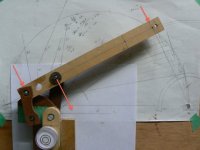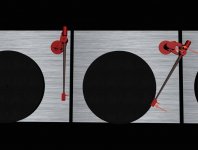Higher mass would need low compliance cartridge. So wouldn't a well made low mass arm with high compliance cartridge be good choice ? A nimble cantilever would easily mimic the groove modulations. Isn't it ? And if one wants to, it would be easy to add mass to a low mass tonearm. Good option/control at our disposal isn't it?
Regards
Regards
You see. You fell into the same trap we all have . Question everything you read. Low mass made higher gives you all options. Compliance stated and actual can be very different. Also the Q is important. I stated what I did to make people think. The Denon is about 8.5 CU from memory. The most remarkable piece of measuring gear I ever found are called ears. Never if you have a pair forget to switch them on. Always disregrd all supposed pick up arm parameters until you have tested the possibilities. You may have been living with a poor example of what your pick up can do for years without realising it. If you go too low and hit the spring frequency then you might need a stronger shelf or accept a less open sound by reducing arm mass. BTW a Shure V15 never restores the drive a DL 110 has. Tracking is similar. If you think through what's happeneing it all makes sence. Stiffer is better. The Denon puts a V15 to shame. Very low tip mass and dainty. Shure is a big stub of diamond on a nothing special tube ( compared with Shures implied spec when V15 2/3 ). The rubber then very soft to allow the larger tip mass to move without record damage. Japan questioned that and made very low mass diamonds to do an equal job. In the process very little energy is wasted in the suspension. JVC X1 being where it all changed. CD 4 required that. It died, the usefulness didn't.
It is little bit difficult for me to comprehend which would have more influence cantilever mass or its suspension or combination of cantilever~suspension~tonearm.
Regards.
Regards.
The JVC X1 cartridge changed the trend towards ultra low tracking weights. People had wrongly infered that lower was best. Denon found that an ideal tracking weight might be 1.7g all things considered. Mostly making the vinyl move a little. Too little chips it and too much melts it. Entre produced a pick up closely related to the Denon ideals. Denon DL110 is the cheapest cartridge that I found that meets the ideal spec. It often is not well suited to standard pre amps. Raise the MM gain to double should suit well ( add same value resistor in paralell to lower feedback arm somewhere, change feedback cap the same way if you like ). Aim to have the same sound level as CD if a CD era amplifier. DL110 can be EQ'ed with 470 nF to get 75 uS. All others I tried of other makes did not work. I would not be surprised if it wasn't exactly 75 uS. The results are excellent. One NE 5532 or MC33078 to give active 3180/318 uS is possible. OPA2604 etc if you like. Into my old Quad 33 radio input the impedance is high and 100 mV. I have a 2 uS passive output filter using 220 R and 10 nF ( D Self idea , Quad did the same ). This also helps avoid PSU hum loops. DL110 should suit Zero 100 very well. 8 CU is a nice compliance value. Lets do a crude calculation. DL 110 + arm = 20g . fo = 1/ 2Pi root ( MC ) = 1000/6.3 root ( 20 x 8 ) the 10 -6 rooted and inverted gives 1000. fo = 1000/ 80 . That is about 12 Hz to a good approximation. A text book figure. If mass is added 8 Hz would be possible. Like all music the lower limit sets midband openess, try it with a big pipe organ. It's a free lunch. If using an Ortofon test record I would exspect fo to be at least 2Hz different to calculated. Often lower. If it lowers to 6 Hz you might find walking in the room difficult. The vertical resonance can be very different to the horizontal. I usually take the vertical as prime. Why I have said this is people making a zero error arm might hate the sound they get. The simple reason might be they didn't consider mass. For what it is worth I can not remember a high compliance pick up that had great dynamics. Classic example. Shure V15 and Shure M44-7. The 44-7 needs a special preamp. In simple terms half the gain of usual, it overloads many. In the SME 5 arm the M44-7 has one of the best sounds I ever heard. It is tempting to think with a JVC type stylus it would beat a Decca London. The JVC X1 was clearly better than JVC Z1 which was a lower cost standard diamond type. I got to know this when building studio transcription decks for 78's. The spare M 44 33/45 stylus was arround. We even had ball styli for Pathe that play middle to outer. M44-7 has about 20 dB less separtaion than lets say a good FM tuner. However that is likely to be only 6 dB worse than our perception limit due to how we hear. That imagines we all have perfect speakers and listening rooms. M44 would need a bit of EQ to be accurate, most LP's are worse. M44 works well into > 100 K, 47 K is not ideal for it.
Denon DL-110 Phono Cartridge Specifications
- Type: Moving coil
- Output voltage: 1.6mV
- Frequency response: 20Hz-45kHz
- Recommended load impedance: over 47k ohms ( I'm using 1M ).
- Channel balance @ 1kHz: Within 1db
- Channel separation @ 1kHz: > 25dB
- Stylus tip: Special elliptical solid diamond with 0.1 x 0.2 mm rectangular cross section
- Compliance: 8 x 10-6 cm/dyne
- Recommended tracking force: 1.8mN +/- 3mN (1.8g +/- 0.3g)
- Color: Red
- Weight: 4.8 g
Denon DL-110 Phono Cartridge Specifications
- Type: Moving coil
- Output voltage: 1.6mV
- Frequency response: 20Hz-45kHz
- Recommended load impedance: over 47k ohms ( I'm using 1M ).
- Channel balance @ 1kHz: Within 1db
- Channel separation @ 1kHz: > 25dB
- Stylus tip: Special elliptical solid diamond with 0.1 x 0.2 mm rectangular cross section
- Compliance: 8 x 10-6 cm/dyne
- Recommended tracking force: 1.8mN +/- 3mN (1.8g +/- 0.3g)
- Color: Red
- Weight: 4.8 g
To correct a little. Ortofon VMS20 did sound dynamic and was at a guess 30 CU. I have sold it with the old Rega R200 Lustre arm ( not RB ). At 1.3g it was a 6.5 Hz resonance in that arm. It felt obviously at the limit on warps yet was wonderful. No Rega suspension to cope with so not a disaster. The VMS in a Dual CS505 was nothing special.
I have a little JVC L-3E DD ( or did have ). It has a zero error arm in concept. The pick up is like an AT95. The total sound is rather good as compared with the Technics 1210. The arm is moved on a simple belt with positioning electronics ( a timed drive would do ). It looks the biggest pile of junk possible. It sounds the opposite. I suspect the motor is very good, said to come from JVC TT71. The arm looks to be very nasty plastic. It isn't. Very solid and rather weighty. I am sorry to say I bought into the closed loop principle too much and this is the moment of truth. This turntable is far removed from a closed loop. It sounds much better than most turntables. It is very dynamic and open. It sounds like a piano when a piano. It says to me a very simple zero tracking error arm could be made. It also plays impossible warps. The JVC was bought for my friend Colleen. It is so good to listen to music at her house. To be honest I never exspected it to be this good. The B&O is neither good nor bad. The elements are so good that is must be close. It really is a beautiful piece of engineering. The MMC 20 pick up is a masterpiece although I don't think I ever found the right arm for it. Hadcock or Naim Aro perhaps ? The Schreoder I'm sure.
Something similar.
https://www.youtube.com/watch?v=MAqHJbE_yvw
Something similar.
https://www.youtube.com/watch?v=MAqHJbE_yvw
Last edited:
Musonic - Ortofon M20FL Super Original Stylus
In theory the Ortofon VMS 20 could not be used in the old Rega R200 arm . Even test disks hinted at the same. Truth is it worked very well. At all times it was obvious it was slightly wrong. Mostly the cartridge had a narrow rake and almost touched the record surface. Warps that should have confirmed the problem didn't ! 1.3 g never was a problem. The M20FL solved all the problems and was simply supurb. 1.7 g and 9.5 Hz resonance. For some reason another VMS was called FF15 E. I really wonder if this was the best of them all? It cost peanuts. VMS 10 came later and seemed slightly less good. The real doubtful one was VMS 30. It should have been the M20FL on paper. It was just lacklustre and not as good as the VMS5 to my ears. Unless you work with turntables and sell 1000's you never get to know this. Never believe anything except your ears. The AT 95 whilst modest is a universally OK pick up.
In theory the Ortofon VMS 20 could not be used in the old Rega R200 arm . Even test disks hinted at the same. Truth is it worked very well. At all times it was obvious it was slightly wrong. Mostly the cartridge had a narrow rake and almost touched the record surface. Warps that should have confirmed the problem didn't ! 1.3 g never was a problem. The M20FL solved all the problems and was simply supurb. 1.7 g and 9.5 Hz resonance. For some reason another VMS was called FF15 E. I really wonder if this was the best of them all? It cost peanuts. VMS 10 came later and seemed slightly less good. The real doubtful one was VMS 30. It should have been the M20FL on paper. It was just lacklustre and not as good as the VMS5 to my ears. Unless you work with turntables and sell 1000's you never get to know this. Never believe anything except your ears. The AT 95 whilst modest is a universally OK pick up.
Supreme-Analog Linear Tonearm
Just when we thought this thread is about to run its course, here comes a new design. It appears to be a variation of the Birch concept and similar to the Schroeder LT minus the magnets. It reminds me of some of the designs we discussed in this thread in the past. I am waiting for more detail on the pivot designs and geometry. Have fun digesting the pictures!
Just when we thought this thread is about to run its course, here comes a new design. It appears to be a variation of the Birch concept and similar to the Schroeder LT minus the magnets. It reminds me of some of the designs we discussed in this thread in the past. I am waiting for more detail on the pivot designs and geometry. Have fun digesting the pictures!
An externally hosted image should be here but it was not working when we last tested it.
An externally hosted image should be here but it was not working when we last tested it.
An externally hosted image should be here but it was not working when we last tested it.
An externally hosted image should be here but it was not working when we last tested it.
An externally hosted image should be here but it was not working when we last tested it.
An externally hosted image should be here but it was not working when we last tested it.
An externally hosted image should be here but it was not working when we last tested it.
An externally hosted image should be here but it was not working when we last tested it.
An externally hosted image should be here but it was not working when we last tested it.
An externally hosted image should be here but it was not working when we last tested it.
An externally hosted image should be here but it was not working when we last tested it.
An externally hosted image should be here but it was not working when we last tested it.
An externally hosted image should be here but it was not working when we last tested it.
An externally hosted image should be here but it was not working when we last tested it.
An externally hosted image should be here but it was not working when we last tested it.
An externally hosted image should be here but it was not working when we last tested it.
An externally hosted image should be here but it was not working when we last tested it.
An externally hosted image should be here but it was not working when we last tested it.
An externally hosted image should be here but it was not working when we last tested it.
An externally hosted image should be here but it was not working when we last tested it.
An externally hosted image should be here but it was not working when we last tested it.
Well, now, that double arm geometry looks familiar somehow.
The concept and the drawings are beautiful. I just keep going back to them with serious envy.
There are aspects, the way the whole thing jack knifes into a tidy package when the arm is on its rest for instance, that I really like. And I hope the ruby bearings work out in this design. I appreciate this approach to using them and I'd like to try them to see if they are an improvement over ceramic hybrids.
I hope this design will be built. Fully realized it will be TA art, a pleasure to view and use.
However, after saying all that, one possible negative did catch my attention: In the drawing of the arm at the lead in position, a line drawn through the pivot arm bearings appears to be less than 90 degrees to a line drawn through at the center line of the wand. My experience is that those two lines have to be at more than 90 degrees. The wand is effectively locked between the trailing arm and the stylus and resulting force has to pass in front of the rear bearing of the pivot arm in order for the entire arm to move forward and across the record. If I haven't made myself clear and if it will help I'll try to do a drawing - (2D, planform, pencil and paper, that sort of thing)
I hope Zoran Mihajlovic knows about this thread and can contribute. I don't Facebook, but maybe someone else could let him know.
DD: Thanks again for bringing more good stuff to our attention.
The concept and the drawings are beautiful. I just keep going back to them with serious envy.
There are aspects, the way the whole thing jack knifes into a tidy package when the arm is on its rest for instance, that I really like. And I hope the ruby bearings work out in this design. I appreciate this approach to using them and I'd like to try them to see if they are an improvement over ceramic hybrids.
I hope this design will be built. Fully realized it will be TA art, a pleasure to view and use.
However, after saying all that, one possible negative did catch my attention: In the drawing of the arm at the lead in position, a line drawn through the pivot arm bearings appears to be less than 90 degrees to a line drawn through at the center line of the wand. My experience is that those two lines have to be at more than 90 degrees. The wand is effectively locked between the trailing arm and the stylus and resulting force has to pass in front of the rear bearing of the pivot arm in order for the entire arm to move forward and across the record. If I haven't made myself clear and if it will help I'll try to do a drawing - (2D, planform, pencil and paper, that sort of thing)
I hope Zoran Mihajlovic knows about this thread and can contribute. I don't Facebook, but maybe someone else could let him know.
DD: Thanks again for bringing more good stuff to our attention.
Last edited:
The return of a friendly website is a joy!
Now, to business! What is the name of the drawing program used to generate these images? It has appeared before (or one like it), and I wondered if it was going to become some kind of submission requirement for patents, et al. ( I say that because the Patent Office used to suggest multiple reader options, but have changed to Adobe-only, like a paid advert.) In any case, the ones in this thread have been skillful and beautiful.
Andy
Now, to business! What is the name of the drawing program used to generate these images? It has appeared before (or one like it), and I wondered if it was going to become some kind of submission requirement for patents, et al. ( I say that because the Patent Office used to suggest multiple reader options, but have changed to Adobe-only, like a paid advert.) In any case, the ones in this thread have been skillful and beautiful.
Andy
Hail to Doug!
Those drawings are nice but they are just drawings.
We must give dtut (Doug Tuthill) credit for actually materializing an arm and showing us that it works.
The Supreme-Analog tonearm is similar to Doug's creation in a more refined package.
Don't forget to revisit post#888 and post#917 and all the comments regarding the design.
-------------------------------------------------------------------------------------
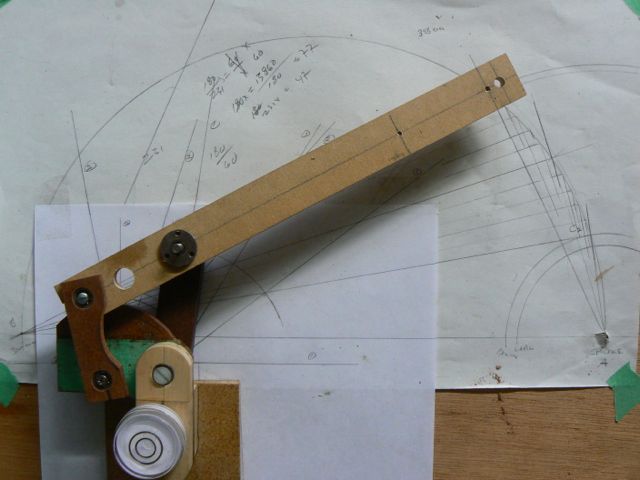
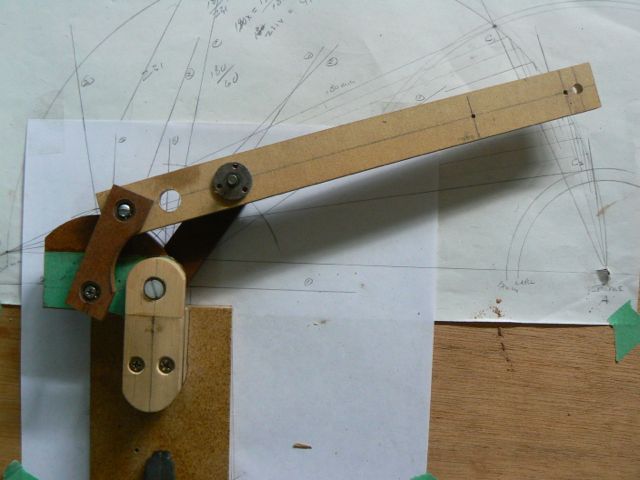
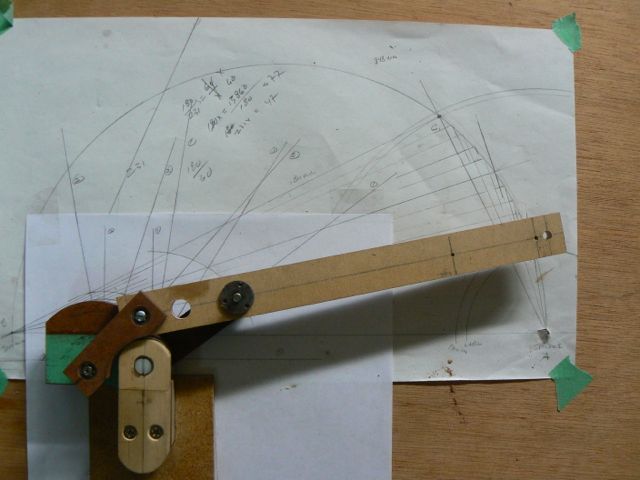
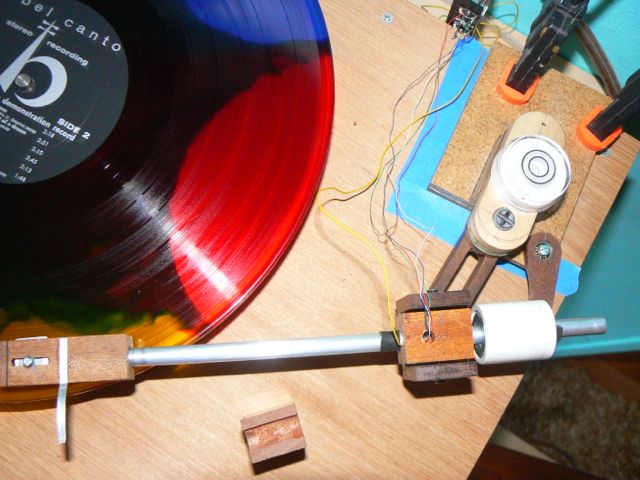
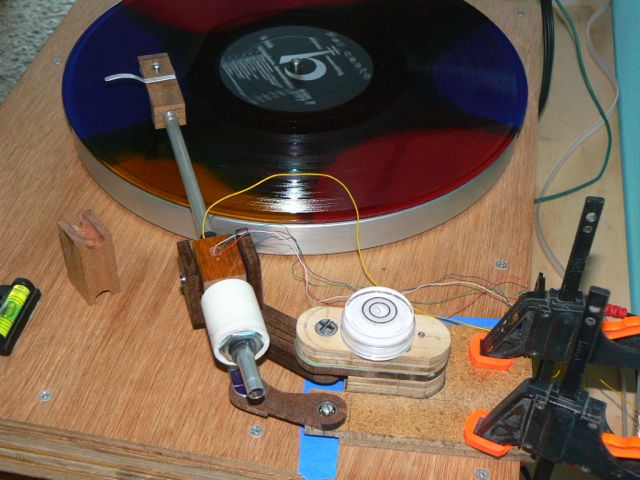
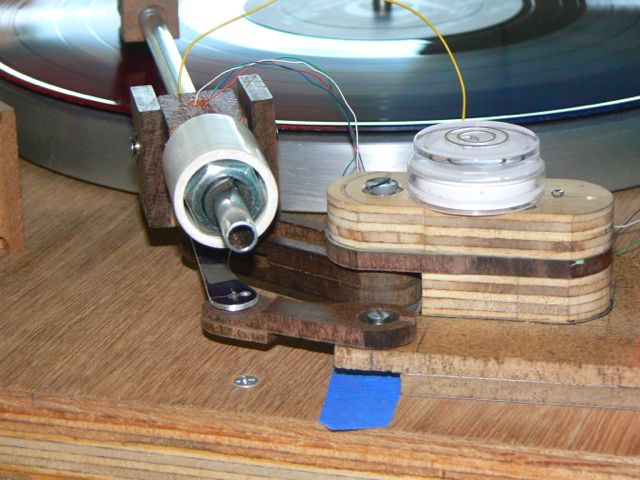
Those drawings are nice but they are just drawings.
We must give dtut (Doug Tuthill) credit for actually materializing an arm and showing us that it works.
The Supreme-Analog tonearm is similar to Doug's creation in a more refined package.
Don't forget to revisit post#888 and post#917 and all the comments regarding the design.
-------------------------------------------------------------------------------------






Hi directdriver, hello Doug!
" It appears to be a variation of the Birch concept and similar to the Schroeder LT minus the magnets..."
Exactly. Nothing that I see in those drawings represents originality...
As directdriver wrote, even Doug's version is no different in principle to my LT arm. The main difference and resulting advantages in the LT arm are the reduction in friction/slack-prone connections, the mechanical de-coupling in the lateral plane and the freedom of deviating from a circle-segment shaped guide curve.
The arm, as shown by Doug (and Mr. Michajlovic) has a considerably higher eff. mass in the lateral plane(vs. the vertical plane) and both will display (higher than neccessary)low frequency speed variations as a result of record eccentricity.
Properly decoupling the main arm in the lateral plane will result in a near elimination of the arm cartridge resonance frequency in that plane. Low frequency modulation(below 100Hz) is all lateral, so the bass will improve markedly due a reduction in intermodulation distorsion.
If Doug was to substitute the secondary(smaller, dark brown) guide bar for a thread and keep that tensioned, friction levels far lower can be achieved AND the mechanical coupling(arm - base) would be easier to properly define. It also allows for using a cam on which the thread acts, just in case one would like to change the dimensions dictated by the Birch equations.
There's more, but I'll wait until I see an actual arm by Mr. Michajlovic... at least Doug built one, - and in a true DIY spirit!
A relaxed Sunday to all,
Frank
" It appears to be a variation of the Birch concept and similar to the Schroeder LT minus the magnets..."
Exactly. Nothing that I see in those drawings represents originality...
As directdriver wrote, even Doug's version is no different in principle to my LT arm. The main difference and resulting advantages in the LT arm are the reduction in friction/slack-prone connections, the mechanical de-coupling in the lateral plane and the freedom of deviating from a circle-segment shaped guide curve.
The arm, as shown by Doug (and Mr. Michajlovic) has a considerably higher eff. mass in the lateral plane(vs. the vertical plane) and both will display (higher than neccessary)low frequency speed variations as a result of record eccentricity.
Properly decoupling the main arm in the lateral plane will result in a near elimination of the arm cartridge resonance frequency in that plane. Low frequency modulation(below 100Hz) is all lateral, so the bass will improve markedly due a reduction in intermodulation distorsion.
If Doug was to substitute the secondary(smaller, dark brown) guide bar for a thread and keep that tensioned, friction levels far lower can be achieved AND the mechanical coupling(arm - base) would be easier to properly define. It also allows for using a cam on which the thread acts, just in case one would like to change the dimensions dictated by the Birch equations.
There's more, but I'll wait until I see an actual arm by Mr. Michajlovic... at least Doug built one, - and in a true DIY spirit!
A relaxed Sunday to all,
Frank
I've e-mailed Zoran Mihajlovic with a link to this thread inviting him to post.
The two photos I've attached show the relative forces on his arm and on mine. The Birch geometry seems to inherently put the pivot arms in the right positions so if may be Mihajlovic is working with something new and different.
I've been using and enjoying the LT for about a year now. It does have different lateral and vertical Eff Masses and has a couple of other glitches, but it still works and sounds good. I've got a new one in mind - it's still a thought experiment - that will probably include Frank's tensioned thread suggestion or maybe something else if I get clever and lucky.
The two photos I've attached show the relative forces on his arm and on mine. The Birch geometry seems to inherently put the pivot arms in the right positions so if may be Mihajlovic is working with something new and different.
I've been using and enjoying the LT for about a year now. It does have different lateral and vertical Eff Masses and has a couple of other glitches, but it still works and sounds good. I've got a new one in mind - it's still a thought experiment - that will probably include Frank's tensioned thread suggestion or maybe something else if I get clever and lucky.
Attachments
hello Doug Tuthill , directdriver, berlinta, RCruz.....
I am new to this forum, I do the drawings of Supreme-Analog Linear Tonearm (zoran mihajlovic is my partner..)
First I want to thank Doug for beautiful words ,I really appreciate this. Doug , you are absolutely right about forces (but in the wands are opposite directions). Zoran publish this a bit early, need some corrections. This geometry is well know probably from old greek, and have infinity solutions, problem is to find one (or group of solutions) who potentiate all criteria ( lead in position, rest position..).I prefer solution with wands opposite to groove guide because is more accurate. this particular solution have a nice "hug" around VTA tower, simple as that. projections of forces is a bit complicate , so I made software for this in autocad program (I am mathematics gay, Phd of mathematics). for a real thing I will vary different geometry, thickness of materials ,bearing, etc....as a cnc gay (my "main" job is project and build cnc machines, robots..) I have many opportunities . if any is interested I will gladly post news .
thanks for comments about Birch concept, Doug Tuthill tonearm, Schroeder LT , I found last two, but nothing about birch concept. if anyone need some help about drawings, solutions, preparations for cnc...I will gladly help if I can.
Andy, if yours question is about my drawings, I use autocad for drawings, but 3ds max for render.
MiiB , its easier to built real thing, then parametric draw for motion..🙂
P.S. sorry about my English and style , English its not my native language..
best regards
sasha
I am new to this forum, I do the drawings of Supreme-Analog Linear Tonearm (zoran mihajlovic is my partner..)
First I want to thank Doug for beautiful words ,I really appreciate this. Doug , you are absolutely right about forces (but in the wands are opposite directions). Zoran publish this a bit early, need some corrections. This geometry is well know probably from old greek, and have infinity solutions, problem is to find one (or group of solutions) who potentiate all criteria ( lead in position, rest position..).I prefer solution with wands opposite to groove guide because is more accurate. this particular solution have a nice "hug" around VTA tower, simple as that. projections of forces is a bit complicate , so I made software for this in autocad program (I am mathematics gay, Phd of mathematics). for a real thing I will vary different geometry, thickness of materials ,bearing, etc....as a cnc gay (my "main" job is project and build cnc machines, robots..) I have many opportunities . if any is interested I will gladly post news .
thanks for comments about Birch concept, Doug Tuthill tonearm, Schroeder LT , I found last two, but nothing about birch concept. if anyone need some help about drawings, solutions, preparations for cnc...I will gladly help if I can.
Andy, if yours question is about my drawings, I use autocad for drawings, but 3ds max for render.
MiiB , its easier to built real thing, then parametric draw for motion..🙂
P.S. sorry about my English and style , English its not my native language..
best regards
sasha
hello Doug Tuthill , directdriver, berlinta, RCruz.....
I am new to this forum, I do the drawings of Supreme-Analog Linear Tonearm (zoran mihajlovic is my partner..)
First I want to thank Doug for beautiful words ,I really appreciate this. Doug , you are absolutely right about forces (but in the wands are opposite directions). Zoran publish this a bit early, need some corrections. This geometry is well know probably from old greek, and have infinity solutions, problem is to find one (or group of solutions) who potentiate all criteria ( lead in position, rest position..).I prefer solution with wands opposite to groove guide because is more accurate. this particular solution have a nice "hug" around VTA tower, simple as that. projections of forces is a bit complicate , so I made software for this in autocad program (I am mathematics gay, Phd of mathematics). for a real thing I will vary different geometry, thickness of materials ,bearing, etc....as a cnc gay (my "main" job is project and build cnc machines, robots..) I have many opportunities . if any is interested I will gladly post news .
thanks for comments about Birch concept, Doug Tuthill tonearm, Schroeder LT , I found last two, but nothing about birch concept. if anyone need some help about drawings, solutions, preparations for cnc...I will gladly help if I can.
Andy, if yours question is about my drawings, I use autocad for drawings, but 3ds max for render.
MiiB , its easier to built real thing, then parametric draw for motion..🙂
P.S. sorry about my English and style , English its not my native language..
best regards
sasha
I am new to this forum, I do the drawings of Supreme-Analog Linear Tonearm (zoran mihajlovic is my partner..)
First I want to thank Doug for beautiful words ,I really appreciate this. Doug , you are absolutely right about forces (but in the wands are opposite directions). Zoran publish this a bit early, need some corrections. This geometry is well know probably from old greek, and have infinity solutions, problem is to find one (or group of solutions) who potentiate all criteria ( lead in position, rest position..).I prefer solution with wands opposite to groove guide because is more accurate. this particular solution have a nice "hug" around VTA tower, simple as that. projections of forces is a bit complicate , so I made software for this in autocad program (I am mathematics gay, Phd of mathematics). for a real thing I will vary different geometry, thickness of materials ,bearing, etc....as a cnc gay (my "main" job is project and build cnc machines, robots..) I have many opportunities . if any is interested I will gladly post news .
thanks for comments about Birch concept, Doug Tuthill tonearm, Schroeder LT , I found last two, but nothing about birch concept. if anyone need some help about drawings, solutions, preparations for cnc...I will gladly help if I can.
Andy, if yours question is about my drawings, I use autocad for drawings, but 3ds max for render.
MiiB , its easier to built real thing, then parametric draw for motion..🙂
P.S. sorry about my English and style , English its not my native language..
best regards
sasha
Sacha,
Welcome to the thread and thank you for posting.
On pg 21, post #209, there's a drawing that shows the Birch geometry. That is the drawing I used for the arms I built. On the same page, post #210, Mark Kelly describes how to draw the pivot points.
On pg 22, #219, Mark describes the math he uses instead of doing the drawings.
On pg 80, #794, 2wice approaches the problem a bit differently and posts calculations and plots.
On pg 83, #822, Jonathon Carr (jcarr) talks about an Excel program he used to determine the error for different pivot arm/swing arm combinations. Farther down he posts some of his results.
I hope this information about the Birch geometry will be helpful.
One of the things I really like about your design is the way the mechanism "hugs" the tower in the resting position, as you say. That's very clever.
I hope you and Mr. Mihajlovic are able to sort the details and build a working model of your arm. Please post your progress.
Your english and your style are very good.
DD: 100 pages and nearly 1000 posts. Ya done good.
Welcome to the thread and thank you for posting.
On pg 21, post #209, there's a drawing that shows the Birch geometry. That is the drawing I used for the arms I built. On the same page, post #210, Mark Kelly describes how to draw the pivot points.
On pg 22, #219, Mark describes the math he uses instead of doing the drawings.
On pg 80, #794, 2wice approaches the problem a bit differently and posts calculations and plots.
On pg 83, #822, Jonathon Carr (jcarr) talks about an Excel program he used to determine the error for different pivot arm/swing arm combinations. Farther down he posts some of his results.
I hope this information about the Birch geometry will be helpful.
One of the things I really like about your design is the way the mechanism "hugs" the tower in the resting position, as you say. That's very clever.
I hope you and Mr. Mihajlovic are able to sort the details and build a working model of your arm. Please post your progress.
Your english and your style are very good.
DD: 100 pages and nearly 1000 posts. Ya done good.
Last edited:
DD: 100 pages and nearly 1000 posts. Ya done good.
Thank you! I want to thank all participants of this thread. I started it almost 6 years ago on a whim and did not expect it to grow into of interest. Could not have done it without you courageous souls here! I started it so let me break the 1000 mark here!
Cheers!

- Home
- Source & Line
- Analogue Source
- Angling for 90° - tangential pivot tonearms
